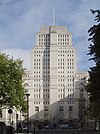Nutford House, London
This article needs additional citations for verification. (November 2008) |

Nutford House is a university hall of residence in London, located on the corner of Nutford Place and Brown Street, near Marble Arch in the City of Westminster.[1]
It was built in 1916 and was acquired by the University of London in 1949, after which it was expanded to take in five terraced houses in Brown Street, known as the Annexe and one house in Seymour Place. Accommodation is provided for 223 men and women students in 181 single and 21 twin rooms.[2]
Nutford House has a total of 181 single rooms, and 21 shared rooms across the main hall, annexe and Seymour Place.[3] The warden for many years was the sole surviving relative of Howard Carter (archaeologist), the discoverer of Tutankhamun's tomb and signed the death certificate (last seen on display at the 1992 British Museum's exhibit of Howard Carter's career before Tutankhamun).
The residence is split into 3 separate accommodations: Main Hall, The Annexe and Seymour. Residents in Seymour Place only have access to laundry facilities and common areas in the main or annex buildings. The House has 2 common rooms in the main building, one of which is a TV room and the other a JCR (Junior Common Room) with a piano. There is no Senior Common Room. There is, however, a music room in the annex. The annex also houses a games room with darts, foosball table, and TV.
References[]
- ^ "Nutford House". London School of Economics. Retrieved 6 August 2020.
- ^ "Nutford House - Nutford House - University of London - Intercollegiate Residences - Student accommodation - Accommodation - Life at LSE - Home". Archived from the original on 2011-04-12.
- ^ "Archived copy". Archived from the original on 2010-03-27. Retrieved 2010-04-13.
{{cite web}}: CS1 maint: archived copy as title (link)
Coordinates: 51°31′02″N 0°09′47″W / 51.5171°N 0.1630°W
- University of London intercollegiate halls of residence
- London building and structure stubs

